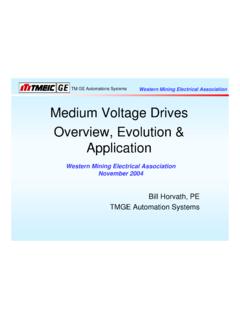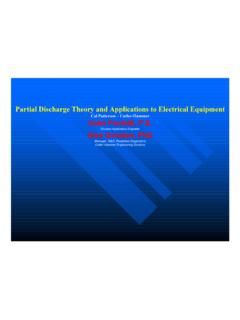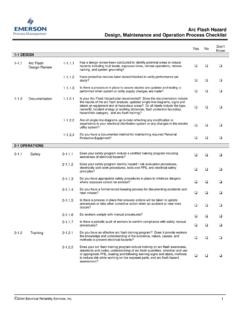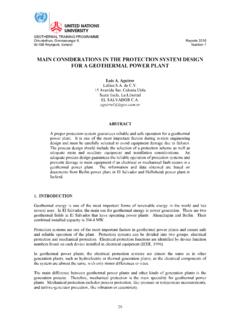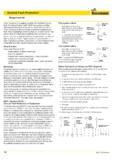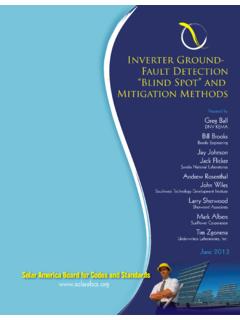Transcription of The Importance of the Neutral-Grounding Resistor …
1 The Importance of the Neutral-Grounding ResistorPresented by: Jeff Glenney, and Don Selkirk, Preview What is high-resistance grounding (HRG)? What is the purpose of HRG? Why is the Neutral-Grounding Resistor (NGR) so important Why monitor the NGR? Code requirements Summary Case studiesWhat is High-Resistance grounding ?High-Resistance grounding of, an electrical power system, is the grounding of the system neutral through a resistance which limits ground-fault current to a value equal to, or slightly greater than the capacitive charging current of that is High-Resistance grounding ?The Neutral-Grounding Resistor is the connection between the system neutral and ground. It provides a path for ground-fault current to return to the transformer neutral . What is High-Resistance grounding ?A properly designed high-resistance-grounded system: Combines the benefits of ungrounded and solidly grounded systems: Allows the user to run with a single ground fault on the system,or shut down in an orderly manner Prevents transient overvoltages and limits voltage fluctuation at the neutral during a ground fault Facilitates the location of ground faults Minimizes the risk of arc flash and arc blast on the first ground fault Limits energy available to a ground-fault fault Provides current to current-sensing ground-fault protectionWire Wound NGREdge Wound NGRNGR in Vented EnclosureWhat is the Importance of the NGR?
2 Why Monitor the NGRWhat are the consequences of an NGR failure?Why Monitor the NGRLoadGround-Fault RelayWhy Monitor the NGR? False Sense of SecurityLoadGround-Fault RelayUNGROUNDED SYSTEM:NORMAL OPERATION & FAULTED OPERATIONN eutral point establishedby distributed capacitance Phase C at ground potential No fault current (no return path to source)All phases are atline-to- neutral voltageabove ground (eg: 347V)A & B phases areat line-line voltageabove ground(eg: 600V)Normal operationGround fault on phase CUNGROUNDED (DELTA) SYSTEM:FAULTED OPERATION WITH TRANSIENT OVERVOLTAGEN ormal operationIntermittent ground fault onphase C A & B phases are:> Line-line voltage above ground Phase C > ground voltage Intermittent fault current Personnel dangerWHY MONITOR THE NGR? False Sense of SecurityUngrounded Wye Open NGRU ngrounded DeltaWhy Monitor the NGR? During a ground-fault the NGR is a critical component.
3 Without the NGR current sensing ground-fault protection does not operate on a ground fault. Does this really matter?Courtesy of Jack Woodham -Jedson EngineeringPOWER SYSTEM grounding COURSEINDUSTRIAL POWER SYSTEMSF ailure of Failures98 %< %< %Most three phase faults are man-made: accidents caused by improper operating a Resistance-Grounded System:In 98 out of every 100 electrical faults the protection system will not operate as designed with out the Monitor the NGR?DESIGN, STARTUP, AND COMMISSIONING OF A 230 KV KV SUBSTATIONEach ground-fault relay has a redundant back up plus the adjacent two main buses and bus tie section zones are protected by full bus differential relays and backed up by partial bus differential protection. Feeder units have two redundant relays. The relays are different models with different CT inputs, but perform the same functions and send simultaneous trips to the feeder circuit breaker.
4 Ground Protection Single LineGround Protection Single LineNGR Monitoring MethodsV Does not monitor NGR continuity, only measures neutral -point voltage and current Active only when GF present This is back-up ground-fault protection, not NGR monitoringAA Superior MethodMonitoring DeviceSensing Resistor Monitors ground current Monitors Voltage at the neutral Continuously monitors the NGR continuity The monitor provides indication of the NGR continuity whether there is a ground-fault or not Isolates the monitor from line-to- neutral voltage Detects NGR failure without an energized loadCode Requirements for NGR MonitoringNGR Monitoring US and Canadian Code References Where is resistance grounding required? Where is monitoring required?US Regulations NEC 2005 Article 250 grounding and (D) Ground-Fault Detection and Relaying. Ground-fault detection and relaying shall be provided to automatically de-energize any high-voltage system component that has developed a ground fault.
5 The continuity of the equipment grounding conductor shall be continuously monitored so as to de-energize automatically the high-voltage circuit to the portable or mobile equipment upon loss of continuity of the equipment grounding Regulations -30 CFR Section Gassy Mines or TunnelsElectric motor-driven mine equipment and accessories 30 CFR Voltage Limitation(2) A continuously monitored, failsafe grounding system is provided that will maintain the frame of the equipment and the frames of all accessory equipment at ground potential. Also, the equipment, including its controls and portable (trailing) cable, will be deenergized automaticallyupon the occurrence of an incipient ground fault. The ground-fault-tripping current shall be limited by grounding Resistor (s) to that necessary for dependable relaying. The maximum ground-fault-tripping current shall not exceed 25 Regulations -30 CFR Section 56 Testing grounding systemsPART 56--SAFETY AND HEALTH STANDARDS SURFACE METAL AND NONMETAL MINES 30 CFR grounding and resistance of grounding systems shall be tested immediately after installation, repair, and modification; and annually thereafter.
6 A record of the resistance measured during the most recent tests shall bemade available on a request by the Secretary or his duly authorized Regulations -30 CFR Section 57 PART 57--SAFETY AND HEALTH STANDARDS UNDERGROUND METAL AND NONMETAL MINES30 CFR grounding and resistance of grounding systems shall be tested immediately after installation, repair, and modification; and annually thereafter. A record of the resistance measured during the most recent tests shall bemade available on a request by the Secretary or his duly authorized Regulations -30 CFR Section 75 Mandatory safety standards--underground coal mines 30 CFR grounding ResistorsThe grounding Resistor , where required, shall be of the proper ohmic value to limit the voltage drop in the grounding circuit external to the Resistor to not more than 100 volts under fault conditions. The grounding Resistor shall be rated for maximum fault current continuously and insulated from ground for a voltage equal to the phase-to-phase voltage of the system.
7 US Regulations -30 CFR Section 75 Mandatory safety standards, surface coal mines and surface work areas of underground coal mines30 CFR grounding ResistorsThe grounding Resistor , where required, shall be of the proper ohmic value to limit the voltage drop in the grounding circuit external to the Resistor to not more than 100 volts under fault conditions. The grounding Resistor shall be rated for maximum fault current continuously and insulated from ground for a voltage equal to the phase-to-phase voltage of the system. US Regulations -30 CFR Section 75 Mandatory safety standards--underground coal mines 30 CFR (3) Electrical Protection3) Ground-fault currents must be limited by a neutral grounding Resistor to not more amperes when the nominal voltage of the power circuit is 2,400 volts or less; amperes when the nominal voltage of the power circuit exceeds 2,400 ) High-voltage circuits extending from the section power center must beprovided protection set to cause deenergization at not more than 40 percent of the rating of the neutral grounding backup ground-fault detection device to cause deenergization when a ground fault occurs with the neutral grounding Resistor open; protection for the grounding Resistor that will deenergize the longwall power center if the Resistor is subjected to a sustained ground fault.
8 The thermal protection must operate at either 50 percent of the maximum temperature rise of the grounding Resistor , or 150 deg. C (302 deg. F), whichever is less, and must open the ground-wire monitor circuit for the high-voltage circuit supplying the section power center. The thermal protection must not be dependent upon control power and may consist of a current transformer and overcurrent Regulations -30 CFR Section 75 Mandatory safety standards--underground coal mines 30 CFR Lighting fixtures; requirements.(2) Alternating current circuits supplying power to stationary lighting fixtures shall contain conductors energized at voltages not greater than 70 volts to ground. Alternating current circuits, energized at 100 volts or more and used to supply power to stationary lighting fixtures, shall originate at a transformer having a center or neutral tap grounded to earth through a proper Resistor , which shall be designed to limit fault current to not more than 5 amperes.
9 A grounding circuit in accordance with shall originate at the grounded terminal of the grounding Resistor andextend along with the power conductors and serve as a grounding conductor for the frames of all equipment receiving power from the circuit. Commonwealth of Pennsylvania -Department of Environmental ProtectionMine Power Substation-The area containing electrical switchgear (circuit breakers, fuses, switches, and/or transformers), used for the purpose of controlling power from the surface power system to the underground mine power transmission. I. Alternating current installations shall include A through Secondary or mine feeder circuit breaker with:4. Automatic tripping of circuit breakers by protective relays and shall provide as a minimum tripping by:f. Ground fault-current limiting Resistor protection and monitoring by current and potential transformer of Pennsylvania -Department of Environmental ProtectionLoad Center13.
10 Main breaker tripping devices, which must include:a. Overload and short circuit protectionb. Ground fault by current Ground fault by potential protector in the event of an open ground Continuous monitoring of the ground Resistor is acceptable in lieu of potential Time delay tripping for coordination of tripping is Regulations Use(1) Should read neutral grounding devices shall be permitted to be used only on systems where all neutral conductors are insulated to the nominal system voltage. (3)Where line-to- neutral loads are served, provision shall be made to automatically de-energize the system on the occurrence of(a) a ground fault;(b) a grounded neutral on the load side of the neutral groundingdevice; or(c) a lack of continuity of the conductor connecting the neutralgrounding device from the neutral point through the neutral grounding device to the system grounding Regulations CSA M421-00 Section M421-00 Use of Electricity in MinesGeneral Protection and Control Ground-Fault ProtectionWhere ground-fault protection is used, the supply shall be(a)Grounded through a Neutral-Grounding device that limits ground-fault voltage to 100 V or less.

